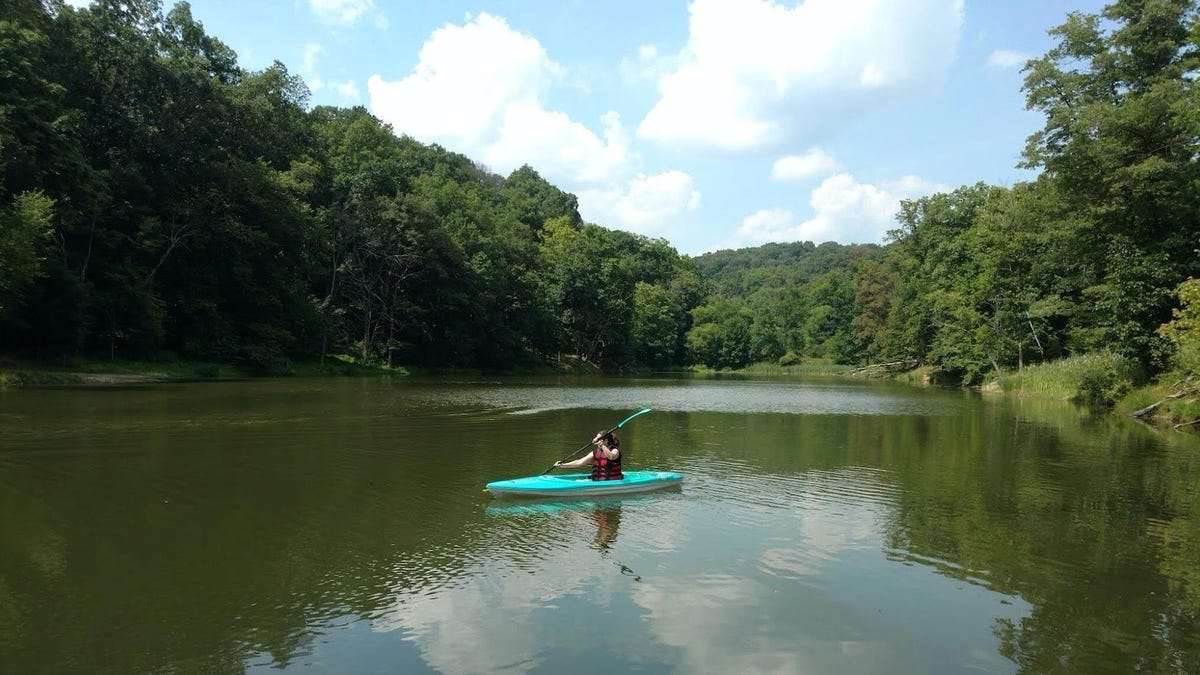
If you don’t care how far or how fast you go, you can get by without any instruction. You certainly don’t need lessons just to tootle around a calm lake. But if you want to move yourself expertly around the water, or if you intend to use paddling as a workout, learning some technique will help.
Advertisement
A proper paddle stroke uses your core and your lats (upper back) to pull the paddle toward you while you brace your body against the boat. You may also have sore deltoids (shoulders) your first time from the work you’re doing in raising the free end of the paddle out of the water. All told, a hard paddling session is somewhere in between a cardio and a strength workout.
What should I do in a kayak?
Once you get used to the mechanics of paddling, you can use your little boat to go exploring. Even on the small lake in my county park, I know that if I start at one end I have a few options for where to go, and I may see different wildlife in different parts of the lake.
Advertisement
Watching nature is the best part for me, because I like birds and cool animals and I’ll often see ones on the lake that I don’t see in my backyard just a few miles away. There’s often a great blue heron standing in the shadows somewhere, maybe green herons hunting for fish down at the swampy end of the lake, a colony of swallows darting around catching bugs, and the occasional swimming muskrat. The other day, an osprey circled above me a few times before finally splashing in to grab a fish. One time I saw a dark brown shape swimming in front of me, and I quietly paddled closer, only to see it dive down and slap the water with its tail. A beaver!
(If you’re into fishing, a boat lets you fish in parts of the lake you can’t reach from land. I don’t know anything about fishing from a kayak, but if you’re a fishing person I’m sure you’ll figure it out or find somebody who does.)
Advertisement
If you get an anchor (as little as $10 at your local bait shop, plus whatever it costs for a length of cord), you can drop it in your favorite part of the lake and chill for a bit. This is a good time to pull out sketching supplies or a packed lunch. Keeping to my “what if I fall in” rule, I only bring blank paper, not a filled sketchbook, and I put my snacks in a paper bag instead of a cute bento.
Kayaking is more fun with friends, but if you bring a dog or a child, please make sure to keep them safe. Children under 12 should always wear a properly-fitting PFD (personal flotation device, aka lifejacket), and no matter how good an idea it seems, they should not be tied to the boat. Same goes for pets—yes, your pup needs a lifejacket.
Advertisement
If you want to buy a kayak
If you enjoy paddling someone else’s kayak, it may be a good idea to buy your own. Just remember that you’re now responsible for supplying your own PFD, paddle, and any other accessories or safety equipment you might need.
Advertisement
There are a few decisions you’ll need to make for the kayak itself:
- Sit-in or sit-on-top? A sit-in kayak is the traditional kind, and keeps you a little bit dryer. A sit-on-top is more convenient if you’d like to hop in and out to go swimming.
- How long? Long skinny kayaks move faster and steer straighter. Shorter, wider ones are a little more stable side-to-side but your paddling won’t be as efficient.
- One person or two? Two-person (tandem) kayaks tend to be longer and heavier, and they may not balance or maneuver appropriately if you paddle them with just one person inside.
- What’s the weight limit? Consider not just your own weight but also whether you’d like to be able to bring a dog, child, or picnic cooler.
Advertisement
Make sure to check the regulations for wherever you paddle; you may need a boat launch permit, for example. And consider whether you can pick up your boat and secure it onto the car by yourself; a lighter kayak is a lot more convenient than a heavier one if you’ll usually be alone.
I ended up getting a very basic 10-foot sit-in kayak. I paddle in calm lakes where a little inefficiency isn’t a big deal, and I figured I would be on my own for most of my outings. The weight limit is enough that I can paddle it with a child, or my husband could paddle it alone. If I had a bigger budget, I probably would have gone for a longer, fancier boat—maybe even a two-person.
Advertisement
When you’re pricing it out, remember that you’ll need a paddle, PFD, and car carrier, and you’ll need a place to store it. (There are some clever storage options available, that will let you keep your kayak on a wall or ceiling.) If storage is a potential dealbreaker, there are also inflatable and foldable kayaks—but more on those next time.
Advertisement

Comentarios recientes